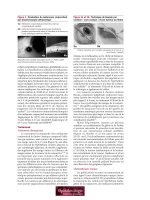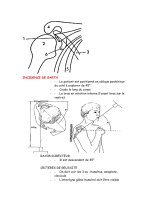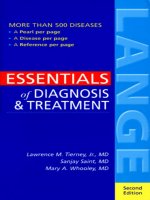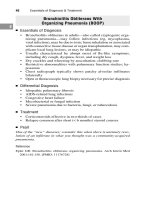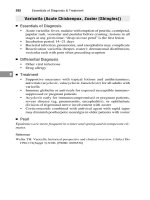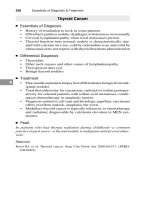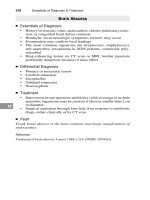DIAGNOSIS & TREATMENT - PART 4 potx
Bạn đang xem bản rút gọn của tài liệu. Xem và tải ngay bản đầy đủ của tài liệu tại đây (478.35 KB, 54 trang )
Systemic Lupus Erythematosus
■
Essentials of Diagnosis
• Predominantly in young women
• Multisystem inflammatory autoimmune disorder with periods of
exacerbation and remission
• Four or more of the following 11 criteria must be present: malar
(“butterfly”) rash, discoid rash, photosensitivity, oral ulcers, ar-
thritis, serositis, renal disease, neurologic disease, hematologic
disorders, positive antinuclear antibody (ANA), and immuno-
logic abnormalities (eg, antibody to native double stranded DNA
or to Sm, or false-positive serologic test for syphilis)
• Also associated with fever, myositis, alopecia, myocarditis, peri-
carditis, vasculitis, lymphadenopathy, conjunctivitis, anti-
phospholipid antibodies with hypercoagulability and miscarriages,
thrombocytopenia, glomerulonephritis (focal, membranoprolifer-
ative, or membranous), sicca complex
• Syndrome may be drug-induced (eg, procainamide, hydra-
lazine), in which case brain and kidney usually spared
■
Differential Diagnosis
• Rheumatoid arthritis
• Vasculitis
• Sjögren’s syndrome
• Systemic sclerosis
• Endocarditis
• Lymphoma
• Glomerulonephritis due to other cause
■
Treatment
• Mild disease (ie, arthralgias with dermatologic findings) often
responds to hydroxychloroquine and COX-2 inhibitors or NSAIDs
• Moderate disease activity (ie, refractory to antimalarials): corticos-
teroids and azathioprine, methotrexate, or mycophenolate mofetil
• Corticosteroids and cyclophosphamide for lupus cerebritis and
lupus nephritis
• Withdraw offending agent if drug-induced lupus suspected
• Avoid sun exposure
■
Pearl
The classic malar rash of SLE spares the nasolabial folds.
Reference
Strand V: New therapies for systemic lupus erythematosus. Rheum Dis Clin
North Am 2000;26:389. [PMID: 10768219]
148 Essentials of Diagnosis & Treatment
6
Systemic Sclerosis (Scleroderma)
■
Essentials of Diagnosis
• Diffuse systemic sclerosis in 20% of patients with generalized
fibrotic changes of the skin and internal organ systems
• Raynaud’s phenomenon typical; may be associated with intesti-
nal hypomotility, pulmonary fibrosis, myocarditis, pericarditis,
hypertension and renal failure, acral ulceration
• Limited disease (80% of patients) or CREST syndrome (calci-
nosis cutis, Raynaud’s phenomenon, esophageal hypomotility,
sclerodactyly, and telangiectasia): skin tightening limited to the
distal extremities and feet, with lower risk of renal disease, later
onset of pulmonary hypertension and biliary cirrhosis, and an
overall better prognosis
• ANA frequently useful in systemic sclerosis; anticentromere anti-
body positive in 1% of patients with diffuse scleroderma and 50%
of those with CREST syndrome; antitopoisomerase I (Scl-70) in
one-third of patients with diffuse systemic sclerosis and 20% of
those with CREST syndrome, and a poor prognostic factor
■
Differential Diagnosis
• Eosinophilic fasciitis
• Overlap syndromes with scleroderma
• Graft-versus-host disease
• Amyloidosis
• Morphea
• Raynaud’s disease
• Cryoglobulinemia
■
Treatment
• Angiotensin-converting enzyme blockers to treat hypertensive
crisis occasionally seen in patients with systemic sclerosis
• Corticosteroids not helpful; penicillamine may be
• Warm clothing, smoking cessation, and extended-release calcium
channel blockers for Raynaud’s phenomenon; intravenous ilo-
prost may be helpful for digital ulcers
• H
2
receptor antagonists or omeprazole for esophageal reflux
■
Pearl
Malabsorption in systemic sclerosis is due not to intestinal fibrosis but
to bacterial overgrowth from hypomotility.
Reference
Clements PJ: Systemic sclerosis (scleroderma) and related disorders: clinical
aspects. Baillieres Best Pract Res Clin Rheumatol 2000;14:1. [PMID:
10882211]
Chapter 6 Rheumatologic & Autoimmune Disorders 149
6
Overlap Syndromes (Mixed Connective Tissue
Disease & Undifferentiated Connective
Tissue Syndrome)
■
Essentials of Diagnosis
• Clinical features of more than one disease (SLE, systemic scle-
rosis, polymyositis, and rheumatoid arthritis)
• Sicca complex (xerostomia, xerophthalmia, dry cough) and myosi-
tis in virtually all patients
• Presence of a specific antibody to ribonuclear protein
• Suggested clinical criteria include three of the following: edema
of the hands, synovitis, myositis, Raynaud’s phenomenon, and
acrosclerosis
• Associated with pulmonary fibrosis, pericarditis, myocarditis,
esophageal hypomotility, glomerulonephritis
• May evolve to one predominant phenotype over time
■
Differential Diagnosis
• SLE
• Systemic sclerosis
• Polymyositis
• Sjögren’s syndrome
• Rheumatoid arthritis
• Eosinophilic fasciitis
• Graft-versus-host disease
■
Treatment
• NSAIDs (eg, ibuprofen, 800 mg three times daily) and COX-2
inhibitors
• Corticosteroids often first-line agent; response good at modest
doses
• Symptomatic relief of dryness with artificial tears, chewing gum,
sialagogues, frequent sips of water
• Warm clothing, smoking cessation, and extended-relief calcium
channel blockers for Raynaud’s phenomenon
■
Pearl
Sicca syndrome is a cause of “refractory” angina; a drop of water with
nitroglycerin makes it stable angina.
Reference
Kasukawa R: Mixed connective tissue disease. Intern Med 1999;38:386. [PMID:
10397074]
150 Essentials of Diagnosis & Treatment
6
Polymyositis-Dermatomyositis
■
Essentials of Diagnosis
• Bilateral proximal muscle weakness
• Periorbital edema and a purplish (heliotrope) rash over the upper
eyelids in many
• Violaceous, occasionally scaly papules overlying the dorsal sur-
face of the interphalangeal joints of the hands (Gottron’s papules)
• Serum CK elevated; ANA only uncommonly positive save in
overlap syndromes; anti-Jo-1 antibodies in the subset of patients
who have associated interstitial lung disease; anti-Mi-2 is more
specific for dermatomyositis but is insensitive
• Muscle biopsy and characteristic electromyographic pattern are
diagnostic
• May be associated with rheumatoid arthritis, SLE, scleroderma,
mixed connective tissue disease; increased incidence of malig-
nancy, especially in older patients
■
Differential Diagnosis
• Endocrine myopathies (eg, hyperthyroidism)
• Polymyalgia rheumatica
• Myasthenia gravis; Eaton-Lambert syndrome
• Muscular dystrophy
• Rhabdomyolysis
• Parasitic myositis
• Drug-induced myopathies (eg, corticosteroids, alcohol, col-
chicine, statins, zidovudine, hydroxychloroquine, one batch of
L-tryptophan)
• Adult glycogen storage disease
• Mitochondrial myopathy
■
Treatment
• Corticosteroids
• Methotrexate or azathioprine spares steroids
• Intravenous immune globulin for some cases of dermatomyositis
• Search for malignancy unwarranted unless historical or exami-
nation findings indicate it
■
Pearl
Biopsy at the site of a previous EMG will show inflammation; pick the
same muscle on the other side.
Reference
Callen JP: Dermatomyositis. Lancet 2000;355:53. [PMID: 10615903]
Chapter 6 Rheumatologic & Autoimmune Disorders 151
6
Sjögren’s Syndrome
■
Essentials of Diagnosis
• Destruction of exocrine glands, leading to mucosal and conjunc-
tival dryness
• Dry mouth (xerostomia) and dry eyes (keratoconjunctivitis sicca),
decreased tear production, parotid enlargement, severe dental
caries, loss of taste and smell
• Occasionally associated with glomerulonephritis, renal tubular
acidosis, biliary cirrhosis, pancreatitis, neuropsychiatric dysfunc-
tion, polyneuropathy, interstitial pneumonitis, thyroiditis, cardiac
conduction defects
• Over 50% have cytoplasmic antibodies, anti-Ro (SS-A), and anti-
La (SS-B)
• Decreased lacrimation measured by Schirmer’s filter paper test;
biopsy of minor salivary glands of lower lip confirms diagnosis
• May also be observed in patients with rheumatoid arthritis, SLE,
systemic sclerosis, polymyositis, polyarteritis, fibrosis; increased
incidence of lymphoma and Waldenström’s macroglobulinemia,
especially in isolated sicca syndrome
■
Differential Diagnosis
• Sicca complex associated with other autoimmune diseases such
as sarcoidosis, rheumatoid arthritis, SLE, and systemic sclerosis
as noted
• Anticholinergic medications
• Chronic irritation from smoking
■
Treatment
• Symptomatic relief of dryness with artificial tears, chewing gum,
sialagogues
• Cholinergic drugs such as pilocarpine
• Meticulous care of teeth and avoidance of sugar-containing
candies
• Corticosteroids or azathioprine; cyclophosphamide for peripheral
neuropathy, interstitial pneumonitis, glomerulonephritis, and vas-
culitis
■
Pearl
Consider parotid tumors before making the diagnosis of Sjögren’s syn-
drome.
Reference
Fox RI et al: Current issues in the diagnosis and treatment of Sjögren’s syn-
drome. Curr Opin Rheumatol 1999;11:364. [PMID: 10503656]
152 Essentials of Diagnosis & Treatment
6
Polyarteritis Nodosa
■
Essentials of Diagnosis
• Fever, hypertension, abdominal pain, arthralgias, myalgias
• Cotton-wool spots and microaneurysms in fundus; pericarditis,
myocarditis, palpable purpura, mononeuritis multiplex, livedo
reticularis
• Acceleration of sedimentation rate in most; serologic evidence of
hepatitis B or hepatitis C in 30–50%
• ANCA positive in most
• Diagnosis confirmed by biopsy or visceral angiography
• Renal or pulmonary involvement in variant microscopic poly-
arteritis
■
Differential Diagnosis
• Wegener’s granulomatosis
• Churg-Strauss vasculitis
• Hypersensitivity vasculitis
• Subacute endocarditis
• Essential mixed cryoglobulinemia
• Cholesterol atheroembolic disease
■
Treatment
• Corticosteroids with cyclophosphamide for systemic vasculitis;
azathioprine is used as a maintenance immunosuppressant
■
Pearl
Treat polyarteritis nodosa with immunosuppressives at your own risk
if endocarditis has not been definitively excluded.
Reference
Savage C et al: ABC of arterial and vascular disease: vasculitis. BMJ 2000;
320:1325. [PMID: 10807632]
Chapter 6 Rheumatologic & Autoimmune Disorders 153
6
Polymyalgia Rheumatica & Giant Cell Arteritis
■
Essentials of Diagnosis
• Patients usually over age 50
• Polymyalgia rheumatica characterized by pain and stiffness, not
weakness, of the shoulder and pelvic girdle lasting 1 month or
more without evidence of infection or malignancy
• Associated with fever, little if any joint swelling, sedimentation
rate > 40mm/h, and rapid response to prednisone 15 mg/d
• Giant cell (temporal) arteritis frequently coexists with polymyal-
gia rheumatica; headache, transient or permanent blindness, jaw
claudication, or temporal artery tenderness; lingual Raynaud’s
phenomenon, scalp necrosis
• Diagnosis confirmation by 5 cm temporal artery biopsy remains
reliable for 1–2 weeks after starting steroids
■
Differential Diagnosis
• Multiple myeloma
• Chronic infection, eg, endocarditis, visceral abscess
• Neoplasm
• Rheumatoid arthritis
• Depression
• Myxedema
• Carotid plaque with embolic amaurosis fugax
• Carotid Takayasu’s arteritis
■
Treatment
• Prednisone 10–20 mg/d for polymyalgia rheumatica
• Prednisone 60 mg/d immediately on suspicion of temporal
arteritis; treat for at least 4 months depending on response of
symptoms—not sedimentation rate
• Methotrexate or azathioprine spares steroids in some patients
with side effects on high doses
■
Pearl
Instruct patients with polymyalgia rheumatica to keep 60 mg of pred-
nisone with them at all times and to take it and come in if there are any
visual symptoms.
Reference
Epperly TD et al: Polymyalgia rheumatica and temporal arthritis. Am Fam
Physician 2000;62:789. [PMID: 10969858]
154 Essentials of Diagnosis & Treatment
6
Churg-Strauss Vasculitis
(Allergic Granulomatosis & Angiitis)
■
Essentials of Diagnosis
• Granulomatous vasculitis of small- and medium-sized arteries
• Four of the following have a sensitivity of 85% and specificity of
100% for diagnosis: asthma; allergic rhinitis; transient pulmonary
infiltrates; palpable purpura or extravascular eosinophils; mono-
neuritis multiplex; and eosinophilia
■
Differential Diagnosis
• Wegener’s granulomatosis
• Eosinophilic pneumonia
• Polyarteritis nodosa (often overlaps)
• Hypersensitivity vasculitis
■
Treatment
• Corticosteroids
• Cyclophosphamide in addition probably has better outcome
■
Pearl
Leukotriene inhibitors such as montelukast, given for asthma, have
been implicated as causing some cases of Churg-Strauss syndrome.
Reference
Eustace JA et al: Disease of the month. The Churg Strauss Syndrome. J Am Soc
Nephrol 1999;10:2048. [PMID: 10477159]
Chapter 6 Rheumatologic & Autoimmune Disorders 155
6
Hypersensitivity Vasculitis
■
Essentials of Diagnosis
• Leukocytoclastic vasculitis of small blood vessels
• Palpable purpura of lower extremities the predominant feature
• Secondary to numerous drugs, neoplasms, connective tissue dis-
orders, congenital complement deficiency, serum sickness, viral
or bacterial infection
• On occasion associated with fever, arthralgias, abdominal pain
with or without gastrointestinal bleeding, pulmonary infiltrates,
kidney involvement with hematuria
■
Differential Diagnosis
• Polyarteritis nodosa
• Henoch-Schönlein purpura
• Essential mixed cryoglobulinemia
• Meningococcemia
• Gonococcemia
■
Treatment
• Treat underlying disease if present
• Discontinue offending drug
• Corticosteroids in severe cases
■
Pearl
The palpable purpura of hypersensitivity vasculitis is dependent and
thus may be prominent on the backs of bedfast patients.
Reference
Savage CO et al: ABC of arterial and vascular disease: vasculitis. BMJ 2000;
320:1325. [PMID: 10807632]
156 Essentials of Diagnosis & Treatment
6
Wegener’s Granulomatosis
■
Essentials of Diagnosis
• Vasculitis associated with glomerulonephritis and necrotizing
granulomas of upper and lower respiratory tracts
• Slight male predominance with peak incidence in fourth and fifth
decades
• Ninety percent present with upper or lower respiratory tract symp-
toms, including perforation of nasal septum, chronic sinusitis, oti-
tis media, mastoiditis, cough, dyspnea, hemoptysis
• Proptosis, scleritis, arthritis, purpura, or neuropathy (mononeuritis
multiplex) may also be present
• cANCA in 90%; sinus, lung, or renal biopsy makes the diagno-
sis, though the latter is seldom specific, showing focal glomeru-
lonephritis; eosinophilia not a feature
• Chest film may reveal large nodular densities; urinalysis may
show hematuria, red cell casts; CT scans of sinuses often reveal
bony erosion
• Increased risk of bladder cancer and lymphoma
■
Differential Diagnosis
• Polyarteritis nodosa
• Churg-Strauss vasculitis
• Goodpasture’s syndrome
• Takayasu’s arteritis
• Microscopic polyarteritis
• Lymphomatoid granulomatosis
• Lymphoproliferative disorders (especially angiocentric T cell
lymphoma)
■
Treatment
• Corticosteroids
• Primarily oral cyclophosphamide or methotrexate in addition
• Trimethoprim-sulfamethoxazole effective in mild disease; given
to all patients not allergic to sulfonamides
■
Pearl
In 10% of renal biopsies, pathognomonic granulomatous vasculitis is
seen in renal arterioles.
Reference
Esper GJ et al: Update on the treatment of Wegener’s granulomatosis. Bull the
Rheumat Dis 1999;48:1. [PMID: 10721552]
Chapter 6 Rheumatologic & Autoimmune Disorders 157
6
Cryoglobulinemia
■
Essentials of Diagnosis
• Refers to any globulin precipitable at lower than body temperature
• Any elevation of globulin may be associated
• Monoclonal gammopathies, reactive hypergammaglobulinemia,
cryoprecipitable immune complexes are the main causes; first
two have acral cold symptoms because of higher titers of cryo-
proteins
• Symptoms and signs depend upon type
• Low erythrocyte sedimentation rate; correctable by doing 37 °C
ESR
■
Differential Diagnosis
• Multiple myeloma, Waldenström’s macroglobulinemia
• Chronic inflammatory diseases such as endocarditis, sarcoidosis,
rheumatoid arthritis
• Essential mixed cryoglobulinemia: palpable purpura and glomeru-
lonephritis in patients serologically positive for hepatitis C
■
Treatment
• Entirely dependent on cause
■
Pearl
In a patient with back pain whose blood “clots” per the laboratory
despite heparinization of the specimen, the diagnosis is myeloma with
a cryoprecipitable M-spike.
Reference
Lamprecht P et al: Cryoglobulinemic vasculitis. Arthritis Rheum 1999;42:2507.
[PMID: 10615995]
158 Essentials of Diagnosis & Treatment
6
Takayasu’s Arteritis (“Pulseless Disease”)
■
Essentials of Diagnosis
• Large-vessel vasculitis involving the aortic arch and its major
branches
• A disease of Asian women under 40
• Associated with myalgias, arthralgias, headaches, angina, clau-
dication, erythema nodosum-like lesions; hypertension, bruits,
absent pulses, cerebrovascular insufficiency, aortic insufficiency
• Angiography reveals narrowing, stenosis, and aneurysms of the
aortic arch and its major branches
• Bruits may be heard over the subclavian arteries or aorta in up to
40% of patients; additionally, there may be a > 10 mm Hg dif-
ference in systolic blood pressure in the two arms
• Rich collateral flow visible in the shoulder, chest, and neck areas
■
Differential Diagnosis
• Giant cell arteritis
• Syphilitic aortitis
• Severe atherosclerosis
■
Treatment
• Corticosteroids
• Cyclophosphamide or methotrexate added for severe disease
• Surgical bypass or reconstruction of affected vessels
■
Pearl
Clinically and pathologically identical to giant cell arteritis except in
the strikingly disparate epidemiology.
Reference
Numano F et al: Takayasu arteritis—beyond pulselessness. Intern Med 1999;
38:226. [PMID: 10337931]
Chapter 6 Rheumatologic & Autoimmune Disorders 159
6
Thromboangiitis Obliterans (Buerger’s Disease)
■
Essentials of Diagnosis
• Inflammatory disease involving small- and medium-sized arter-
ies and veins of the distal upper and lower extremities
• Occurs primarily in young Jewish men who are heavy cigarette
smokers
• Associated with migratory superficial segmental thrombophlebitis
of superficial veins, absent peripheral pulses, claudication, numb-
ness, paresthesias, Raynaud’s phenomenon, ulceration and gan-
grene of fingertips and toes
• Angiography reveals multiple occluded segments in the small- and
medium-sized arteries of the arms and legs
■
Differential Diagnosis
• Atherosclerosis
• Raynaud’s disease
• Livedo reticularis due to other cause
• Antiphospholipid antibody syndrome
• Cholesterol atheroembolic disease
■
Treatment
• Smoking cessation is essential
• Warm clothing, nifedipine for Raynaud’s phenomenon
• Surgical sympathectomy of some value
• Amputation required in some
■
Pearl
The addiction to nicotine is fierce; patients continue to smoke even with
limb prostheses.
Reference
Olin JW: Thromboangiitis obliterans (Buerger’s disease). N Engl J Med 2000;
343:864. [PMID: 10995867]
160 Essentials of Diagnosis & Treatment
6
Behçet’s Syndrome
■
Essentials of Diagnosis
• Usually occurs in young adults from Mediterranean countries or
Japan; incidence decreases if patient’s descendants emigrate else-
where
• Most common: recurrent oral aphthous ulcerations (99%), genital
ulcers (80%), ocular lesions in half (uveitis, hypopyon, iritis, ker-
atitis, optic neuritis), and skin lesions (erythema nodosum, super-
ficial thrombophlebitis, cutaneous hypersensitivity, folliculitis)
• Less common: gastrointestinal erosions, epididymitis, glomeru-
lonephritis, cranial nerve palsies, aseptic meningitis, and focal
neurologic lesions
• Pathergy test—a papule or a pustule forms 24–48 hours after
simple trauma such as a needle prick.
• Diagnosis is clinical
• HLA-B5 histocompatibility antigen often present
■
Differential Diagnosis
• HLA-B27 spondyloarthropathies
• Oral aphthous ulcers
• Herpes simplex infection
• Erythema multiforme
• SLE
• HIV infection
• Infective endocarditis
■
Treatment
• Local mydriatics in all patients with eye findings to prevent syn-
echiae from forming
• Corticosteroids
• Colchicine (for erythema nodosum and arthralgia)
• Azathioprine, cyclosporine in some
■
Pearl
Stroke in a young native Japanese woman is Behçet’s syndrome unless
proved otherwise.
Reference
Sakane T et al: Behçet’s disease. N Engl J Med 1999;341:1284. [PMID:
10528040]
Chapter 6 Rheumatologic & Autoimmune Disorders 161
6
Ankylosing Spondylitis
■
Essentials of Diagnosis
• Gradual onset of backache in adults under age 40 with progres-
sive limitation of back motion and chest expansion
• Diminished anterior flexion of lumbar spine, loss of lumbar lor-
dosis, inflammation at tendon insertions
• Peripheral arteritis and anterior uveitis in many
• Aortic insufficiency with cardiac conduction defects in some
• Cauda equina syndrome, apical pulmonary fibrosis are late com-
plications
• HLA-B27 histocompatibility antigen present in over 90% of
patients; rheumatoid factor absent
• Radiographic evidence of sacroiliac joint sclerosis; demineral-
ization and squaring of the vertebral bodies with calcification of
the anterior and lateral spinal ligaments (bamboo spine)
■
Differential Diagnosis
• Rheumatoid arthritis
• Osteoporosis
• Reactive arthritis
• Arthritis associated with inflammatory bowel disease
• Psoriatic arthritis
• Diffuse idiopathic skeletal hyperostosis (DISH)
• Synovitis-acne-pustulosis-hyperostosis-osteitis (SAPHO) syn-
drome
■
Treatment
• Physical therapy to maintain posture and mobility
• NSAIDs (eg, indomethacin 50 mg three times daily) often mar-
ginally effective
• Sulfasalazine reported effective in some patients
• Intra-articular corticosteroids for synovitis; ophthalmic cortico-
steroids for uveitis
• Surgery for severely affected joints; anti-TNF agents may be
effective but are toxic
■
Pearl
In a patient with burned-out ankylosing spondylitis and symptomatic
“benign prostatic hyperplasia,” test the cauda equina distribution
neurologically before undertaking prostatectomy.
Reference
Koehler L et al: Managing seronegative spondarthritides. Rheumatology 2000;
39:360. [PMID: 10817767]
162 Essentials of Diagnosis & Treatment
6
Psoriatic Arthritis
■
Essentials of Diagnosis
• Classically a destructive arthritis of distal interphalangeal joints;
many patients also have peripheral arthritis involving shoulders,
elbows, wrists, knees, and ankles, often asymmetrically
• Sacroiliitis in B27-positive patients
• Occurs in 15–20% of patients with psoriasis
• Psoriatic arthritis associated with nail pitting, onycholysis,
sausage digits, arthritis mutilans (severe deforming arthritis)
• Rheumatoid factor negative; serum uric acid may be elevated
• Radiographs may reveal irregular destruction of joint spaces and
bone, pencil-in-cup deformity of the phalanges, sacroiliitis
■
Differential Diagnosis
• Rheumatoid arthritis
• Ankylosing spondylitis
• Arthritis associated with inflammatory bowel disease
• Reactive arthritis
• Juvenile spondyloarthropathy
■
Treatment
• NSAIDs (eg, ibuprofen, 800 mg three times daily) or COX-2
inhibitors
• Intra-articular corticosteroid injection; sterilize skin carefully as
psoriatic lesions are colonized with staphylococci and streptococci
• Gold salts, methotrexate
• Sulfasalazine reportedly effective in patients with symmetric poly-
arthritis
• Treatment of psoriasis helpful in many but not in sacroiliitis
■
Pearl
In an arthritis of uncertain cause, examination of the intergluteal folds
can give the diagnosis.
Reference
Gladman DD: Psoriatic arthritis. Rheum Dis Clin North Am 1998;24:829.
[PMID: 9891713]
Chapter 6 Rheumatologic & Autoimmune Disorders 163
6
Reactive Arthritis
■
Essentials of Diagnosis
• Predominantly found in young men
• Triad of urethritis, conjunctivitis (or uveitis), and arthritis which
may occur within a month of another sign or symptom; conjunc-
tivitis may be subtle and evanescent
• Follows dysenteric infection (with shigella, salmonella, yersinia,
campylobacter) or sexually transmitted infection (with chlamydia)
• Asymmetric, oligoarticular arthritis typically involving the knees
and ankles
• Associated with fever, mucocutaneous lesions, stomatitis, aortic
regurgitation, optic neuritis, circinate balanitis, prostatitis, kerato-
derma blennorrhagicum, pericarditis
• HLA-B27 histocompatibility antigen in most
■
Differential Diagnosis
• Gonococcal arthritis
• Rheumatoid arthritis
• Ankylosing spondylitis
• Psoriatic arthritis
• Arthritis associated with inflammatory bowel disease
• Juvenile spondyloarthropathy
■
Treatment
• NSAIDs (eg, indomethacin, 50 mg three times daily); often in-
effective
• Tetracycline for associated Chlamydia trachomatis infection;
obtain VDRL, consider HIV testing
• Azathioprine, methotrexate in severe cases
• Sulfasalazine may help in some patients
• Intra-articular corticosteroids for arthritis, ophthalmic cortico-
steroids for uveitis
■
Pearl
Synovial fluid occasionally shows characteristic cells: large mononu-
clear cell with ingested polymorphonuclear leukocytes which may have
inclusion bodies.
Reference
Barth WF et al: Reactive arthritis (Reiter’s syndrome). Am Fam Physician
1999;60:499. [PMID: 10465225]
164 Essentials of Diagnosis & Treatment
6
Arthritis Associated with Inflammatory
Bowel Disease
■
Essentials of Diagnosis
• Peripheral arthritis: asymmetric oligoarthritis that typically in-
volves the knees, ankles, and occasionally the upper extremities,
usually parallels bowel disease in activity
• Spondylitis: clinically identical to ankylosing spondylitis; HLA-
B27 antigen present in most patients in a male:female ratio of 4Ϻ1
• Articular features may precede intestinal symptoms, especially in
Crohn’s disease
• Extra-articular manifestations may also occur in Crohn’s dis-
ease (erythema nodosum) and in ulcerative colitis (pyoderma
gangrenosum)
■
Differential Diagnosis
• Reactive arthritis
• Ankylosing spondylitis
• Psoriatic arthritis
• Rheumatoid arthritis
■
Treatment
• Treat underlying intestinal inflammation
• Aspirin, other NSAIDs (eg, indomethacin, 50 mg three times
daily)
• Physical therapy for spondylitis
■
Pearl
The younger the patient, the less the gastrointestinal complaints; thus,
arthritis in adolescence should prompt a search for inflammatory bowel
disease despite absence of symptoms.
Reference
De Keyser F et al: Bowel inflammation and the spondyloarthropathies. Rheum
Dis Clin North Am 1998;24:785. [PMID: 9891711]
Chapter 6 Rheumatologic & Autoimmune Disorders 165
6
Septic Arthritis (Nongonococcal Acute
Bacterial Arthritis)
■
Essentials of Diagnosis
• Acute pain, swelling, erythema, warmth, and limited movement
of joints
• Typically monarticular; knee, hip, wrist, shoulder, or ankle most
often involved
• Infection usually occurs via hematogenous seeding of the sy-
novium
• Previous joint damage and intravenous drug abuse predispose
• Most common organisms: Staphylococcus aureus, group A strep-
tococci, Escherichia coli, and Pseudomonas aeruginosa; Haemo-
philus influenzae in children under 5; Staphylococcus epidermidis
following arthroscopy or joint surgery
• White cell count in synovial fluid > 100,000/µL; synovial fluid
culture positive in 50–75%, blood culture in 50%
■
Differential Diagnosis
• Gonococcal arthritis
• Microcrystalline synovitis
• Rheumatoid arthritis
• Still’s disease
• Infective endocarditis (may be associated)
■
Treatment
• Intravenous antibiotics should be administered empirically
• Surgical evaluation for drainage and irrigation of the knee
• Affected hip joint usually requires surgical drainage
• Rest, immobilization, and elevation
• Removal of prosthetic joint
■
Pearl
Pneumococcal arthritis in the absence of pneumonia or endocarditis
means multiple myeloma until proved otherwise.
Reference
Carreño Pérez L: Septic arthritis. Baillieres Best Pract Res Clin Rheumatol
1999;13:37. [PMID: 10052848]
166 Essentials of Diagnosis & Treatment
6
Gonococcal Arthritis
■
Essentials of Diagnosis
• Most common in young women during menses or pregnancy
• Tenosynovitis in many joints followed by monarticular arthritis
• Characteristic purpuric skin lesions on the distal extremities
• White cell count in synovial fluid 50,000/µL; synovial fluid Gram
stain and culture uncommonly positive; likewise blood cultures
• Urethral, cervical, throat, skin lesion and rectal cultures on choco-
late or Thayer-Martin agar for Neisseria gonorrhoeae have higher
yield, may be positive in the absence of symptoms
• Recurrent disseminated gonococcal infection seen with congen-
ital complement component deficiencies
■
Differential Diagnosis
• Nongonococcal bacterial arthritis
• Reactive arthritis
• Lyme disease
• Sarcoidosis
• Infective endocarditis
• Meningococcemia with arthritis
• Seronegative spondyloarthropathy
■
Treatment
• Obtain VDRL, consider HIV testing
• Intravenous ceftriaxone or ceftizoxime for 7 days followed by
oral cefixime or ciprofloxacin
• Daily reaspiration of the synovial fluid if it reaccumulates
■
Pearl
Surprisingly trivial destructive articular changes for a bacterial arthri-
tis.
Reference
Cucurull E et al: Gonococcal arthritis. Rheum Dis Clin North Am 1998;
24:305. [PMID: 9606761]
Chapter 6 Rheumatologic & Autoimmune Disorders 167
6
Infectious Osteomyelitis
■
Essentials of Diagnosis
• Infection usually occurs via hematogenous seeding of the bone;
metaphyses of long bones and vertebrae most frequently involved
• Subacute, vague pain and tenderness of affected bone or back with
little or no fever in adults; more acute presentation in children
• Organisms include Staphylococcus aureus, coagulase-negative
staphylococci, group A streptococci, gram-negative rods, anaer-
obic and polymicrobial infections, tuberculosis, brucellosis,
histoplasmosis, coccidioidomycosis, blastomycosis
• Blood cultures may be positive; aspiration or biopsy of bone is
diagnostic
• Radiographs early in the course are often negative, but periartic-
ular demineralization, erosion of bone, and periostitis may occur
later
• Radionuclide bone scan is 90% sensitive and may be positive
within 2 days after onset of symptoms
■
Differential Diagnosis
• Acute bacterial arthritis
• Rheumatic fever
• Cellulitis
• Multiple myeloma
• Ewing’s sarcoma
• Metastatic neoplasia
■
Treatment
• Intravenous antibiotics after appropriate cultures have been ob-
tained
• Oral ciprofloxacin, 750 mg twice daily for 6–8 weeks, may be
effective in limited osteomyelitis
• In older patients, treat with broad-spectrum antibiotics as for a
gram-negative bacteremia as a consequence of urinary, biliary,
intestinal, and lower respiratory infections
• Debridement if response to antibiotics is poor
■
Pearl
In re chronic osteomyelitis: once an osteo, always an osteo.
Reference
Lew DP et al: Osteomyelitis. N Engl J Med 1997;336:999. [PMID: 9077380]
168 Essentials of Diagnosis & Treatment
6
Eosinophilic Fasciitis
■
Essentials of Diagnosis
• Occurs predominantly in men
• Pain, swelling, stiffness, and tenderness of the hands, forearms,
feet, or legs evolving to woody induration and retraction of sub-
cutaneous tissue within days to weeks
• Associated with peripheral eosinophilia, polyarthralgias, arthritis,
carpal tunnel syndrome; no Raynaud’s phenomenon
• Biopsy of deep fascia is diagnostic
• Association with aplastic anemia, thrombocytopenia
■
Differential Diagnosis
• Systemic sclerosis
• Eosinophilia myalgia syndrome
• Hypothyroidism
• Trichinosis
• Mixed connective tissue disease
■
Treatment
• NSAIDs
• Short course of corticosteroids
• Antimalarials
■
Pearl
Perhaps the only systemic disease in medicine confined strictly to the
fascia.
Reference
Varga J et al: Eosinophilia-myalgia syndrome, eosinophilic fasciitis, and related
fibrosing disorders. Curr Opin Rheumatol 1997;9:562. [PMID: 9375286]
Chapter 6 Rheumatologic & Autoimmune Disorders 169
6
Fibrositis (Fibromyalgia)
■
Essentials of Diagnosis
• Most frequent in women ages 20–50
• Chronic aching pain and stiffness of trunk and extremities, espe-
cially around the neck, shoulder, low back, and hips
• Must have 11 of 18 bilateral tender points: occiput, low cervical,
trapezius, supraspinatus, second rib at costochondral junction,
lateral epicondyle, gluteal region, greater trochanter, and medial
fat pad of the knee
• Associated with fatigue, headaches, subjective numbness, sleep
disorders, irritable bowel symptoms, and history of sexual or
domestic abuse
• Absence of objective signs of inflammation; normal laboratory
studies, including erythrocyte sedimentation rate
■
Differential Diagnosis
• Chronic fatigue syndrome
• Rheumatoid arthritis
• SLE
• Depression
• Polymyalgia rheumatica
• HIV disease
■
Treatment
• Patient education, supportive care, exercise programs
• Aspirin, other NSAIDs
• Tricyclics, cyclobenzaprine, chlorpromazine
• Injection of trigger points with corticosteroids
■
Pearl
A tender point is defined as pain elicited with application of 4 kg of
pressure, the same amount required to cause a fingernail to blanch.
Reference
Leventhal LJ: Management of fibromyalgia. Ann Intern Med 1999;131:850.
[PMID: 10610631]
170 Essentials of Diagnosis & Treatment
6
Amyloidosis
■
Essentials of Diagnosis
• A group of disorders characterized by deposition in tissues of
ordinarily soluble peptides
• Amyloid protein (with characteristic green birefringence under
polarizing microscope after Congo red staining) may be found on
biopsy of rectal mucosa, gingival mucosa, bone marrow, or aspi-
ration of abdominal fat pad
• May be primary (idiopathic or myeloma-associated), familial,
localized, or secondary to familial Mediterranean fever, chronic
infectious or inflammatory disease, aging, hemodialysis; in each,
a different protein is responsible
• Distribution depends on type of amyloid; most systemic, but
localized amyloid found in Alzheimer’s plaques, islet cells in dia-
betics, carpal ligaments in dialysis patients
• Associated variably and unpredictably with peripheral neurop-
athy, postural hypotension, nephrotic syndrome, cardiomyopa-
thy, arrhythmias, esophageal hypomotility, hepatosplenomegaly,
gastrointestinal malabsorption and obstruction, carpal tunnel syn-
drome, macroglossia, arthropathy, endocrine gland insufficiency,
respiratory failure, cutaneous lesions, and ecchymoses
• M-spike in primary amyloidosis
■
Differential Diagnosis
• Hemochromatosis
• Sarcoidosis
• Waldenström’s macroglobulinemia
• Metastatic neoplasm
• Other causes of nephrotic syndrome
■
Treatment
• Colchicine to prevent attacks of familial Mediterranean fever
when present
• Melphalan, prednisone if myeloma-associated
• Treat underlying disease if present
■
Pearl
The combination of nephrotic syndrome and hepatosplenomegaly in a
middle-aged patient is amyloidosis; only rarely can other single pro-
cesses do it.
Reference
Gertz MA et al: Amyloidosis. Hematol Oncol Clin North Am 1999;13:1211.
PMID: 10626146]
Chapter 6 Rheumatologic & Autoimmune Disorders 171
6
Reflex Sympathetic Dystrophy
■
Essentials of Diagnosis
• Usually follows direct trauma to the hand or foot, knee injury,
stroke, peripheral nerve injury, or arthroscopic knee surgery
• Severe pain and tenderness, most commonly of the hand or foot,
associated with vasomotor instability, skin atrophy, and hyper-
hidrosis
• Shoulder-hand variant with restricted ipsilateral shoulder move-
ment common after neck or shoulder injuries or following myo-
cardial infarction
• Characteristic disparity between degree of injury (usually mod-
est) and degree of pain (debilitating)
• Triple phase bone scan reveals increased uptake in the early phases
of the disease; radiographs show severe osteopenia (Sudeck’s atro-
phy) late in the course
■
Differential Diagnosis
• Rheumatoid arthritis
• Polymyositis
• Scleroderma
• Gout, pseudogout
• Acromegaly
• Multiple myeloma
• Osteoporosis due to other causes
■
Treatment
• Supportive care
• Physical therapy
• Active and passive exercises combined with benzodiazepines
• Stellate ganglion or lumbar sympathetic block
• Short course of corticosteroids given early in course
■
Pearl
A far more common disorder when prolonged bed rest was prescribed
for myocardial infarction.
Reference
Lopez RF: Reflex sympathetic dystrophy. Timely diagnosis and treatment can
prevent severe contractures. Postgrad Med 1997;101:185. [PMID: 9126211]
172 Essentials of Diagnosis & Treatment
6

